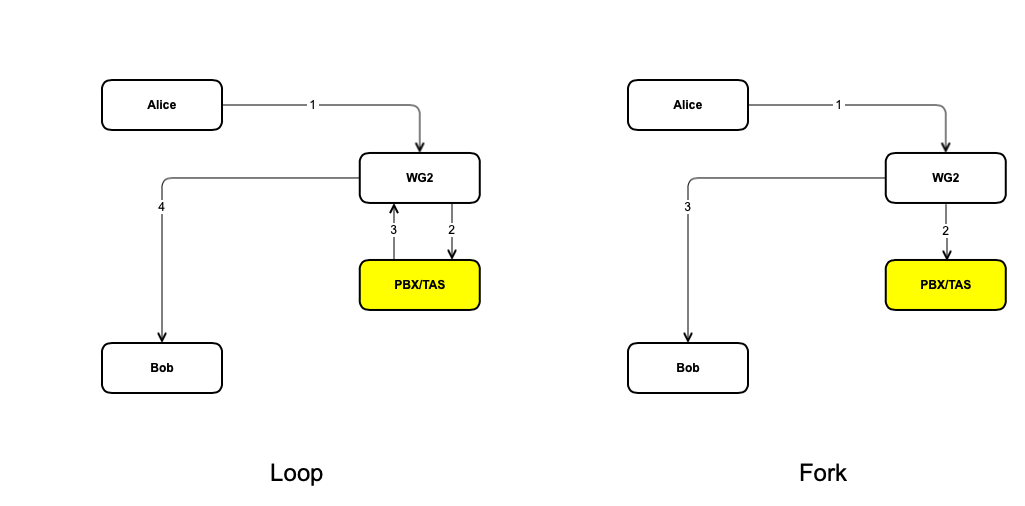Register
Prerequisites
Overview
This API enables PBX/TAS (Private Branch Exchange/Telephony Application Server) providers to plug their (SIP-enabled) endpoint into the call path.
It enables a SIP integration between the platform core and a PBX/TAS for a given MSISDN.
Virtual SIP Registrations are used to alter default call behavior and involve PBX/TAS into the SIP signaling path. When using user tokens the registration created per single MSISDN linked to the OAuth 2.0 round trip, while when using client tokens the registration is created for the provided MSISDN in the request.
Required scope
call.routing:write
The API
The API is implemented as a gRPC service described below.
There are two methods supported by this API:
UpsertRegistrationDeleteRegistration
To register a (PBX/TAS-bound) MSISDN with our core, use UpsertRegistration. The same method is used if you want to update an existing registration.
Use DeleteRegistration when an existing registration is no longer needed.
Messages
Both methods receive RegistrationRequest and return RegistrationResponse message.
RegistrationRequestis a structure containing the URI of the endpoint you host + some additional details related to the connected MSISDN.RegistrationResponseis a simple structure conveying the status of method invocation (success/error)
You may find the proto definition of the service + the definition of the messages exchanged here.
Registration types
There are three types of registrations: Fork, Loop and Fallback. It is the registration type that decides how the calls will be handled by our core.
Fork/Loop
If a registration of one of these types is registered on an MSISDN, all the SIP signalling from/to that MSISDN will be replicated to the endpoint specified in the registration.

Loop: leg 4 is created only after the call comes back as leg 3
Please note that PBX/TAS is not obliged to create leg 3 as it can answer or reject leg 2 directly.
Fork: legs 2 and 3 are created simultaneously.
Typically, you use
Fork/Loopto implement your logic during a call.
Loop MO/MT
For better control of the Loop logic, 2 subtypes of LOOP route type exists:
ROUTE_TYPE_LOOP_MO: Will loop a call only if direction of the call is mobile originating (outgoing call). This means any MT calls for a registration with this route type would not be looped to the sip uri in the registration. The use case for using this type would be for example: Call Center for outgoing callsROUTE_TYPE_LOOP_MT: Will loop a call only if direction of the call is mobile terminating (incoming call). This means any MO calls for a registration with this route type would not be looped to the sip uri in the registration. The use case for using this type would be for example: Business Phone Systems with BYOD policy (route incoming business calls to personal user devices)
INGRESS
ROUTE_TYPE_INGRESS allows PBX/TAS to place calls to MSISDN attached to the registration of that type. Regular calls to/from that MSISDN are not affected otherwise.
Fallback
The core will action upon a Fallback registration if and only if:
- somebody calls the related MSISDN
- the MSISDN is either busy or no answer detected within the timeout (30s)
In such case, the core will replicate the INVITE to the endpoint specified during the registration.
Typically, you use
Fallbackto implement the likes of voice mail, call forwarding etc.
Example code
The examples below demonstrate how to consume this API.
TIP
You can test our APIs without authorization by targetting sandbox.api.wgtwo.com instead of api.wgtwo.com and removing any authorization from the request/code sample.
Download proto definitions
curl -sL 'https://github.com/working-group-two/wgtwoapis/blob/master/image.bin?raw=true' -o wgtwo.bin
export ACCESS_TOKEN="my_access_token"
grpcurl -protoset wgtwo.bin \
-H "Authorization: Bearer $ACCESS_TOKEN" \
-d '
{
"registration": {
"mobileOriginatingPrefix": "11",
"mobileTerminatingPrefix": "22",
"sipUri": "sips:example.com:8888",
"routeType": "ROUTE_TYPE_LOOP",
"phoneNumber": {
"e164": "+4799990000"
}
}
}
' \
api.wgtwo.com:443 \
wgtwo.sipbreakout.v1.SipBreakoutService/UpsertRegistration
2
3
4
5
6
7
8
9
10
11
12
13
14
15
16
17
18
NOTE: If you want to use SRV DNS records, use the domain name without port number in sipUri, then make sure you have SRV records for _sip._tcp.yourdomain.com and _sips._tcp.yourdomain.com defined.
Example result
Success
{
"statusCode": "STATUS_CODE_OK"
}
2
3
Error
{
"statusCode": "STATUS_CODE_NOT_ACCEPTABLE",
"errorMessage": "Secure SIP domain name required"
}
2
3
4
Install dependencies
Maven
<dependency>
<groupId>com.wgtwo.api.v1.grpc</groupId>
<artifactId>sipbreakout</artifactId>
<version>1.10.1</version>
</dependency>
package com.example.sipbreakout
import com.wgtwo.api.v1.common.e164
import com.wgtwo.api.v1.sipbreakout.DeleteRegistrationRequest
import com.wgtwo.api.v1.sipbreakout.Registration
import com.wgtwo.api.v1.sipbreakout.RouteType
import com.wgtwo.api.v1.sipbreakout.SipBreakoutServiceGrpc
import com.wgtwo.api.v1.sipbreakout.UpsertRegistrationRequest
import com.wgtwo.auth.BearerTokenCallCredentials
import io.grpc.ManagedChannelBuilder
/** Use the sandbox environment for testing without authentication */
private val environment = Environment.SANDBOX
private val endpoint = when (environment) {
Environment.SANDBOX -> "sandbox.api.wgtwo.com"
Environment.PRODUCTION -> "api.wgtwo.com"
}
private val channel = ManagedChannelBuilder.forAddress(endpoint, 443).build()
private val stub = SipBreakoutServiceGrpc.newBlockingStub(channel).run {
/**
* If you are not using the sandbox, you need to add credentials.
* The BearerTokenCallCredentials class can be found in our auth library.
*/
if (environment == Environment.PRODUCTION) {
withCallCredentials(BearerTokenCallCredentials { "MY_CLIENT_ACCESS_TOKEN" })
} else {
this
}
}
fun main() {
val registration = Registration.newBuilder().apply {
sipUri = "sips:example.com:8888"
mobileOriginatingPrefix = "11"
mobileTerminatingPrefix = "22"
routeType = RouteType.ROUTE_TYPE_LOOP
phoneNumber = e164 {
e164 = "+99991111"
}
}.build()
val upsertRequest = UpsertRegistrationRequest.newBuilder()
.setRegistration(registration)
.build()
println("upsert request:\n$upsertRequest")
val upsertResponse = stub.upsertRegistration(upsertRequest)
println("upsert response:\n$upsertResponse")
val deleteRequest = DeleteRegistrationRequest.newBuilder()
.setRegistration(registration)
.build()
println("delete request:\n$deleteRequest")
val deleteResponse = stub.deleteRegistration(deleteRequest)
println("delete response:\n$deleteResponse")
}
2
3
4
5
6
7
8
9
10
11
12
13
14
15
16
17
18
19
20
21
22
23
24
25
26
27
28
29
30
31
32
33
34
35
36
37
38
39
40
41
42
43
44
45
46
47
48
49
50
51
52
53
54
55
56
Example result
Success
status_code: STATUS_CODE_OK
Error
statusCode: STATUS_CODE_NOT_ACCEPTABLE
errorMessage: Secure SIP domain name required
2